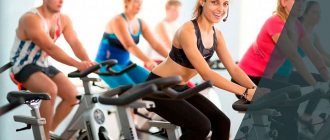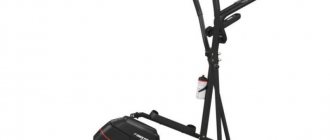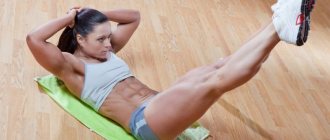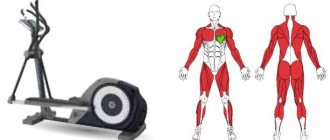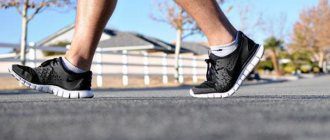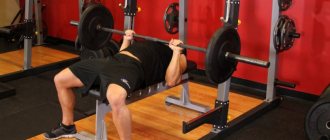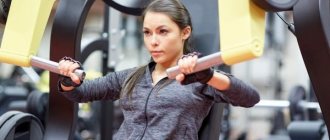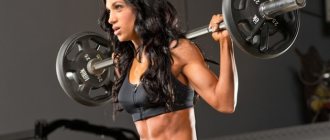- August 12, 2019
- Workouts in the gym
- Tatiana Udalova
Working out on a rowing machine is one of the hottest trends in the fitness world. Experts say that using this machine as a cardio training tool allows you to burn approximately 10-15% more calories than running or cycling! From this article you will learn how to properly exercise on a rowing machine and what success it will allow you to achieve in building your dream body.
Where to study?
A rowing machine is commonly found in all gyms, but you can also purchase one for use at home. If you're looking for home workout equipment but don't have much space, a rowing machine may be the perfect option. It is relatively lightweight and does not take up as much space as other fitness equipment. You can choose an option in both the high and low price segments. Often, a rowing machine is even cheaper than a treadmill or bicycle.
https://youtu.be/6xW6x5TUW4s
Simple rowing
Most people avoid the rowing machine because they don't know how to use it. It is important to understand the technique correctly, otherwise an incorrectly performed exercise can lead to injury.
A simple basic exercise consists of 3 steps:
- Start. Sit on the rowing machine, bend your knees, place your feet on the platform and secure them well with the help of bindings. Then stretch your arms forward and firmly grasp the handle. Make sure your back is straight and your abs tight.
- Jerk. Push up with your legs and straighten them completely. At the same time, pull the handle of the machine with outstretched arms.
- Finish. Once your legs are fully straightened, lean back at a 45-degree angle. Keep your arms extended. Then return to the starting position.
Contraindications
The apparatus imitates rowing on the water, repeating the movements of oars as accurately as possible. Let's look at it in more detail. Main functions of the device:
- develops and strengthens muscles, keeps them in good shape;
- effective for weight loss (burns fat deposits);
- stretches and strengthens tendons and ligaments;
- straightens posture, corrects coordination of movements.
Important! If you have a herniated spine or osteochondrosis, the load on your back during exercise on the exercise machine should be as gentle as possible. It is advisable to create a training program with a professional trainer.
Capabilities and features of a sports instrument:
- brings exercises as close as possible to real rowing on water (some models, thanks to the built-in fan, imitate the blowing of wind);
- you can adjust the intensity of the workout (equipped with a timer);
- it is possible to monitor the pulse and other indicators of the body;
- easy to fold;
- easy to maintain;
- easy to move using special rollers;
- provided with stable supports.
The design and principle of operation of existing models may differ slightly, but the basis of all designs is the same:
- flywheel - provides tension and stretching of the cable;
- seat;
- handles (oars).
Currently there are 3 types of devices:
- Mechanical ones are compact, inexpensive, suitable for beginners, since they can easily adjust the degree of load.
- Magnetic - silent, equipped with a computer that allows you to select the program and intensity.
- Aerodynamic - more suitable for gyms, take up a lot of space, and are noisy. The package includes a fan that creates additional resistance to air flow.
Benefits and indications
Thanks to the large amplitude of movement, the effectiveness of working out almost all muscles is ensured: shoulders, back and abdomen, legs and arms, chest area. Indications for use and benefits of training on a rowing machine:
- improved blood circulation;
- improvement of lung function - tissues are saturated with oxygen;
- strengthening the heart muscle and blood vessels;
- normalization of the central nervous system;
- maintaining muscle tissue in tone, muscle relief;
- help in the fight against diseases and deformities of the spine.
The main advantage of the rowing machine is its smooth motion: it provides an even load on the knee and hip joints, eliminating the risk of injury.
In addition to the benefits, sports activities on a rowing machine have a number of contraindications:
- brain disorders;
- serious heart disease;
- shoulder joint problems;
- displacement of intervertebral discs.
Important! If you have existing health problems, you should consult your doctor before starting classes.
The disadvantages of the simulator also include its dimensions: some designs take up a lot of space and can also make noise.
Types of traction
The rowing simulator has 2 types of traction:
- Central - ideal for practicing at home. Allows you to involve 80% of the muscle tissue in the work, work it out as much as possible, and load it evenly.
- Scandinavian - more designed for professionals. Simulates rowing and works your back as much as possible.
With proper organization of training on this apparatus and a selected program, the following muscles will be involved:
- chest large;
- deltoid;
- trapezoidal;
- anterior abdominal wall;
- shoulder;
- forearms;
- biceps;
- triceps;
- gluteus maximus;
- anterior thigh;
- quadriceps femur;
- straight femoral;
- ischiocavernosus;
- gastrocnemius.
A rowing simulator is one of the few types of exercise equipment that not only pumps up muscles, but also strengthens tendons. Regular training increases the body's endurance, immunity, and improves skin condition.
For complete and effective training, beginners will need advice from professional trainers.
Let's look at what you need to consider when training on a rowing machine:
- You need to exercise in comfortable, loose clothing that does not restrict movement.
- Shoes should not slip.
- Drink water between sets.
- Before exercise, the muscles need to be warmed up with a warm-up, and afterward they need to be worked on with restorative stretching.
- It would be correct to start the lesson with medium intensity (up to 25 strokes per minute).
- All movements should be smooth, without sudden jerks.
- Do not overstrain your knee joints.
- There is no need to lean forward too much when following the cable.
- If painful sensations occur, you need to slow down the pace or change the manner of performing the exercise.
The effect of the workout will depend on how correctly you do it. Basic principles of the technique:
- Starting point: legs bent at the knees, feet standing straight, palms clasping the handles of the exercise machine. The back is straight with a slight bend forward, its muscles are relaxed, the abs and triceps are tense.
- Starting the movement: tense your shoulders and use your legs to push away from the support. Simultaneously with the push, straining your arms, pull the cable toward you to the area under your chest. During the movement, the back is leveled, the thoracic region “comes forward”, the legs are straightened.
- Completion point: the handles of the exercise machine are as close to the body as possible, the abdominal muscles are tense, the elbows are pulled back. At the end of the movement, the hips and buttocks tighten.
- Returning to the starting point: overcoming resistance, smoothly release the cable away from you while holding the handles. Slowly leaning forward with your body, bend your knees.
https://www.youtube.com/watch?v=qLq6iIqNCxQ
The main effort (traction) occurs during inhalation, and relaxation occurs during exhalation.
When choosing an exercise machine for your home, you should consider many factors and parameters. The market is replete with various models of rowing simulator designs. Let's look at the most popular of them.
Read more about how to choose a bench press.
Side rowing
This modification of the classic rowing exercise not only works the arm muscles, but also helps strengthen the oblique abdominal muscles. This modification of simple rowing increases the load on the pectoral muscles.
- Take the “Start” position. Make sure your back is straight.
- Now push up, straightening your legs.
- At the same time, pull the handles to your left side and lean back.
- Do 8 reps on the left side and then repeat on the right.
Rowing[edit | edit code]
Trainer's notes[edit | edit code]
Rowing with one oar or two oars (sculling) requires approximately the same things from your body. Pull the oars towards you, overcoming the resistance of the water, then lift, returning to their original position - this engages the front muscles of the shoulders (biceps), chest (pectoralis major), back of the shoulders (triceps), back of the upper shoulders (latissimus) and the upper backs (large round). As you row, your core muscles (mostly the subscapularis) keep you upright, stabilize you, and help you when you lean over. The abdominal muscles are used to bend forward. The lower back muscles help you lean back. All this time, the feet stand firmly on the supports so that you can bend and straighten the muscles of the hips, knees and lower leg muscles, “rolling” back and forth, transferring the force through the whole body to the arms and then to the oars. Rhythm, coordination, balance, strength, flexibility and endurance are very important here.
The most common injuries in rowing are the knees. The athlete sits in a very “collapsed” position, performing rather specific, repetitive movements. The knees, which help move the body back and forth, also move in a very specific way. Syndromes of irritation and overload of the knee joint are common. Then there are lower back injuries, which are caused by pressure from the bench and stress from rowing. Rowing can be so strenuous that the athlete may suffer stress fractures to the ribs. Additionally, we see soreness in the wrists and forearms caused by overuse, especially in cold weather.
Rowing is a great exercise, but not enough. Add weight training to build strength, flexibility exercises to increase range of motion, and aerobic exercise to build cardiovascular fitness and endurance. Get plenty of rest before the season starts. Warm up well before each time you go out on the water. Replenish fluids and stay warm.
Sprints or extreme rowing
This variation is used to increase the cardio effect of the exercise. Sprints reduce the intensity of the resistance while increasing the speed of the row. This leads to more aerobic activity, which helps burn excess calories.
- In this exercise, you perform a regular rowing exercise, but the difference is that you do not return the handle all the way to the starting position.
- Increase your rowing speed, stopping in the “Snatch” position.
- Do as many repetitions as possible in 1 minute. To make the exercise more challenging, you can increase the time period and rowing speed.
Simple rowing with gymnastics
This is no longer a variation of rowing, but a separate workout. The peculiarity is that we alternate rowing with gymnastic exercises.
- Do one rowing set (12 times) or for 1 minute.
- Then do 8 alternating lunges.
- Do the rowing approach again.
- Then do 8 squats.
- Do a final rowing set.
You can replace lunges and squats with other exercises, depending on which muscle groups you want to focus on in your workout.
Content
- 1 Canoeing 1.1 Coach's Notes
- 2.1 Trainer's notes
- 3.1 Trainer's notes
Alternating between simple and extreme rowing
As a result of this alternation, you will increase your heart rate and warm up your muscles well before the main workout. It can also be used as a cool-down at the very end of a workout.
- Make a playlist of three songs (choose songs with a speed of 150-180 quadruple beats per minute).
- During the first track, perform simple rowing at a steady pace.
- During the second track, maintain an easy, steady tempo until the chorus, then switch to an extreme sprint until the end of the chorus. Repeat for each chorus and guitar solo, for rock fans, easing the tempo during the verse.
- Do the same during the third track. Don't forget: you can always rest where you need it. Take a break when the playlist ends.
Traditions
In the West, rowing has long-standing traditions, which are strictly and even enthusiastically supported by athletes. The main ones:
- Since the beginning of the 19th century, the classic Royal Regatta has been taking place in London on the River Thames, in which the crews of Oxford and Cambridge compete.
- The most common swimming distance, if you do not take into account children's and youth competitions, is 2 km. The exception is a few British classic races.
- Stewards hold the boats until the starting signal. No equipment is used at the start.
- If the team wins the race, the helmsman is thrown into the water. If there is no helmsman on the team, then all crew members jump into the pond holding hands.
Benefits of Using a Rowing Machine
So, let's look at ten reasons why you should ditch the treadmill and start using a rowing machine:
- Rowing is an effective aerobic exercise that helps keep your heart and lungs healthy.
- With a rowing machine, you get a full body workout by targeting all major muscle groups. This is one of the few exercises that works both your upper and lower body, saving you valuable time!
- The rowing exercise on a machine is extremely effective for losing weight, as it simultaneously provides both strength training and cardio. This allows you to burn fat and build muscle at the same time!
- Rowing is extremely beneficial for working on endurance and flexibility.
- The machine provides a wider range of motion than walking or running.
- The rowing machine provides more resistance than cycling. The continuous pulling and rowing motion provides resistance in not one, but two directions.
- The absence of a strong impact on the joints allows rowing even for older people, as well as those who have problems with the musculoskeletal system or are recovering from injuries.
- The rowing machine is quite safe, which reduces the risk of injury.
- Rowing is a good option to include in a CrossFit program.
- The rowing machine is convenient and effective. It burns more calories in less time.
Disadvantages of Using a Rowing Machine
Despite all the advantages of rowing, there are also disadvantages that are worth considering:
- Risk of injury to the lower back. Rowing may not be suitable for people who have back or spinal problems. There is also a high risk of injury when using incorrect exercise technique.
- The amount of noise produced by rowing machines can be significant, making them impractical for many people.
- A subjective disadvantage, but for some people it is significant - it becomes boring quite quickly, it is impossible to read during training.
Features of the exercises
Let's start with the basics.
By applying more force when exercising on a rowing machine, emphasizing the pushing moment, you gain increased resistance from the mechanism. There must be a recovery phase; its time interval is logically increased for beginners, and several times shorter for those who have been training on the simulator for several months.
Interval training is a guarantee that you will not get bored, plus the total time spent is considerably saved. The optimal schedule for experienced ones: 60-120 seconds in high-activity mode, and then reset the pace for 30-50 seconds to slow or medium.
Having purchased a rowing machine and thinking about how to perform standard exercises on it correctly, you should first master the technique of movement, clearly in accordance with the phases. Starting from the pushing part and supplementing with “reaching” with your hands.
Speaking about the duration of classes, it can be argued that the standard for experienced rowing machine users is 40-60 minutes. A beginner can stop at 15-20. By the way! Some models (namely, their on-board computer), focusing on your initially specified level of training, can themselves offer an optimal training time interval.
At the introductory stage it is appropriate:
- Carry out preparatory exercises, including, among other things, a set of exercises to stretch the back muscles (as well as the thigh muscles).
- Adjust the height parameters of the simulator leg to the size of your foot. The main criterion is that the fixing strap is located at the location of the base of the toes, while the front part of the sports shoe protrudes beyond the platform of the simulator by 1-2 cm.
- When grasping the handle of the exercise machine, do not squeeze it desperately. The grip with your fingers and the heel of your hand should be soft, cat-like, but stable.
When starting a movement, do not first tilt your body back and pull the handle with your hands. The technique of working on a rowing machine involves a pushing movement with the legs (not with the fingers, since in this case there will be no effect, and it is easier to injure the Achilles tendon) in the first phase of the row, with the subsequent transfer of force to the muscles of the shoulder girdle, as well as the back.
To avoid back injury, do not bend it. It should be in a neutral position. And we repeat, it is not recommended to strongly squeeze the handle of the simulator with your hands; the result will be a pulling movement at the start, while a pushing movement is necessary.
Only the completed recovery phase guarantees that the next approach will be successful and you will be able to develop the necessary effort. By alternating the active phase of training with moments of rest, you will be able to complete the work plan on the simulator, otherwise you will become exhausted very soon. And the risk of injury will increase significantly.
And a few more points. When exercising on a rowing machine, your gaze should be directed straight ahead and your head position should be elevated. This helps maintain the rhythm of breathing and a stable supply of oxygen to the lungs. To avoid excessive overload of the joints, the hands should be in line with the forearm, without bending them.
- You need to sit on the seat of the rowing machine and position yourself, observing the following parameters: your legs are strictly bent at the knees, you rest on the platform with your feet (their upper part).
- Bend smoothly forward and grasp the handle of the unit without straining your wrist.
- We begin the phase of the exercise - deadlift (it starts with inhalation). We straighten our legs and push off from the surface with them, transferring the main weight to the heel. We pull the handle with a systematic movement towards your body (namely, the stomach, abdominal area).
- We bend our arms and, stretching our shoulders, bring our shoulder blades together.
- We are entering the return phase. From spreading your shoulder blades to fully straightening both arms and bending your legs. The goal is obvious - to take the starting position.
In fact, there is no difficulty at all. And, having brought the movement to automaticity, you can easily carry out 40-50 minutes of successful training.
The rowing machine is launched, we figured out how to perform the exercises correctly for greater benefit. Let's dwell on one more point - types of strokes. Namely – short and long. The first helps strengthen the muscles of the back and arms, the second has a positive effect on the shoulder girdle and torso. Both types give the same load to the buttocks and leg muscles.
There are not so many fundamental differences in technology, but they do exist. With a short stroke, the movement in the pull phase moves progressively towards the torso, with a long stroke - towards the chin. Also, importantly, a long stroke actively engages the muscles of the lower back.
